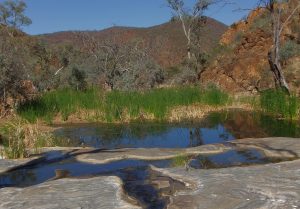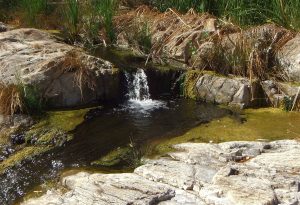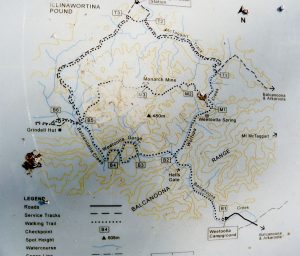 Weetootla Gorge is located on the Eastern side of the Vulkathunha-Gammon Ranges National Park (V-GRNP). It is one of very few places, perhaps the only place, in the ranges where water flows more or less permanently and over some distance. An endangered fish, the purple spotted gudgeon, lives in the water. Yellow-footed rock wallabies are occasionally seen in the Gorge.
Weetootla Gorge is located on the Eastern side of the Vulkathunha-Gammon Ranges National Park (V-GRNP). It is one of very few places, perhaps the only place, in the ranges where water flows more or less permanently and over some distance. An endangered fish, the purple spotted gudgeon, lives in the water. Yellow-footed rock wallabies are occasionally seen in the Gorge.
Marked walking trails allow people to walk into the area from Weetootla camping ground and Grindell’s Hut. In 2012, surveys of the Weetootla and Balcanoona creeks assessed the quality of the creek environments as good but not as good as had been expected. The Friends of Vulkathunha-Gammon Ranges National Park has committed itself to an environmental monitoring program for Weetootla Gorge and this program is about to commence.
Vulkathunha-Gammon Ranges National Park is a wilderness park with most of it being accessible only on foot. Adelaide Bushwalkers club (ABW) has a history of trips to the park and a long-standing interest in the conservation of wild places. This article aims to let club members, who might be interested in participating, know about the V-GRNP friend’s group environmental monitoring program. Anyone who is interested can contact me by e-mail at raywen@bigpond.net.au. The Friends of Vulkathunha-Gammon Ranges National Park have a website at www.rayh.id.au/vulkathunha.
The elements of the monitoring program include:
 Participation in the monitoring project is on the basis that people meet their own expenses in getting to and from the park. For each working visit to the park the Friends group will be applying, beforehand, for free accommodation during the park stay.
Participation in the monitoring project is on the basis that people meet their own expenses in getting to and from the park. For each working visit to the park the Friends group will be applying, beforehand, for free accommodation during the park stay.
There is a small group of people who will get this project going but, to ensure its viability over the long term, more are needed. The group has a capacity to provide training to people joining it and anyone who is interested should not feel reluctant to get involved just because they do not currently have experience or expertise related to the project.
It is intended to make two visits per year to the park with each visit involving 2/3 days of work on site. Most monitoring will be done at locations 1-2 hours walking time from a vehicle.



I have just returned from a vist to this area and am heartbroken to See the impact of prolonged drought in this area. Surprisingly the Springs are still flowing and fish were spotted in the pools . However, while there is water there is no feed for grazing wild life and the area is littered with dead yellow footed rock wallabies and bird life is sparse. The few remaining rock wallabies are hanging around the Grindles hut area begging for food from the campers.
The situation is worse in the Bararranna gorge area where only the large gums in the creek beds survive while the surrounding vegetation on the hillsides is dead or dying. I counted over 30 wallaby corpses, even dead shinglebacks and snakes, in a 3 hour walk through the gorge. Can anything be done? 30/7/19.